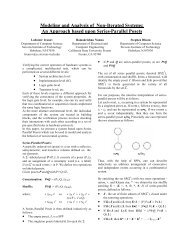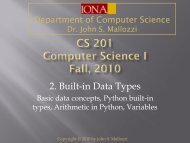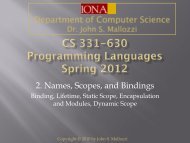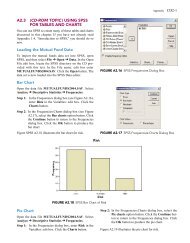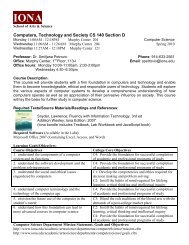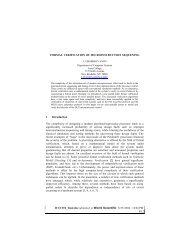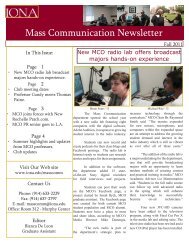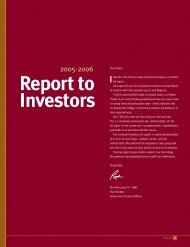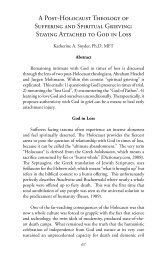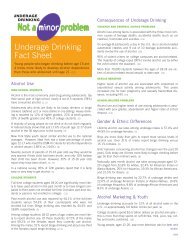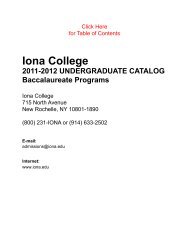Syllabus - Iona College
Syllabus - Iona College
Syllabus - Iona College
Create successful ePaper yourself
Turn your PDF publications into a flip-book with our unique Google optimized e-Paper software.
FALL/SPRING 2006 - 2007<br />
IONA COLLEGE<br />
DEPARTMENT OF CHEMISTRY<br />
CHEMISTRY 309/310 CLASS MEETING TIMES: Tu, W, F 8:00<br />
INSTRUCTOR: Jerome S. Levkov<br />
CLASS LOCATION:<br />
OFFICE LOCATION: Cornelia 105<br />
OFFICE HOURS: Tu 10:00, W 11:00, F<br />
10:00<br />
PHONE: 914 633-2279<br />
Or anytime by mutual<br />
FAX: 914 633-2240 agreement<br />
Email: jlevkov@iona.edu<br />
COURSE DESCRIPTION:<br />
Topics covered generally include:<br />
Solids, liquids and gases; solutions of non-electrolytes; elementary thermodynamics; kinetics;<br />
homogeneous equilibrium; solutions of electrolytes; conductance; electromotive force; deviations from<br />
ideal behavior; heterogeneous equilibrium and Phase Rule, introduction to atomic and molecular<br />
structure; energy of molecules, elementary statistical mechanics. Three lectures a week.<br />
Prerequisite: CHM. 109-110; Math 232; PHY 101, 102<br />
COURSE OBJECTIVES:<br />
Physical Chemistry is the study of the molecular world and the interpretation of macroscopic properties<br />
and behavior in terms of the detailed properties and behavior of molecules. The course is designed for<br />
student who have had calculus and who have followed a modern approach in their elementary chemistry<br />
courses. The primary aim of the course is to instill in the student an appreciation and understanding of<br />
the basic concepts, their interrelationships and their applications in the development of modern<br />
chemistry, in particular the relation between the molecular and macroscopic.<br />
Students leaving this course will be familiar with the basic principles of thermodynamics, kinetics, and<br />
quantum mechanics. They will have experience in applying these principles through solving illustrative<br />
problems.<br />
PROCEDURES:<br />
The class work consists of lecture and general clarification of fundamentals by class discussion where<br />
the instructor and students both pose and answer questions of each other. Student participation in these<br />
discussions is of primary importance in this course because it demonstrates constant acquisition of new<br />
knowledge, and the ability to relate previous understanding of fundamentals to newly acquired<br />
knowledge. Numerous problems are assigned for homework. Illustrative problems drawn from many<br />
areas are used in class.
REQUIRED TEXT:<br />
Physical Chemistry by Keith J. Laidler, John H. Meiser, and Bryan C. Sanctuary<br />
Houghton Mifflin Company, 4th Ed. (2003)<br />
SUGGESTED SUPPLEMENT:<br />
Applied Mathematics For Physical Chemistry by James R. Barrante, Prentice Hall, 3rd Ed., (2004)<br />
GRADING CRITERIA:<br />
3 Hourly Exams 60 points<br />
Final Exam<br />
30 points<br />
Homework<br />
10 points<br />
POLICY ON PLAGIARISM AND ACADEMIC DISHONESTY:<br />
ALL INSTANCES OF ACADEMIC DISHONESTY, CHEATING, AND PLAGIARISM WILL<br />
BE REPORTED TO THE OFFICE OF THE DEAN FOR ACADEMIC DISCIPLINE. ALL<br />
PAPERS, EXAMS, AND ASSIGNMENTS ON WHICH DISHONESTY IS CONFIRMED WILL<br />
RECEIVE A GRADE OF ZERO.<br />
POLICY ON PLAGIARISM AND ACADEMIC DISHONESTY
PHYSICAL CHEMISTRY<br />
(CHM 309)<br />
(TENTATIVE SYLLABUS)<br />
WEEK CHAPTER PROBLEMS<br />
1 Ch.1, The Nature of Physical Chemistry 1: 1,4,5,6,7(b),8,9,12,16,<br />
and the Kinetic Theory of Gases, pp. 1-29 23,27,28<br />
2 Ch. 1, (Cont’d.), pp. 29-43 1: 30,32(a),34,35,36,37,40<br />
48,50,53,60<br />
Ch. 2, The First Law of Thermodynamics<br />
pp. 49-59 2: 3,5,6,11,12<br />
3 Ch2., The Fisrt Law of Thermodynamics 2: 15 24,26,32,36,43,45<br />
pp. 59-86<br />
4 Ch.3, The Second and Third Laws 3: 1,2,5<br />
of Thermodynamics, pp. 92-117<br />
5 Ch. 3, (Cont’d), pp.117-142 3: 6,7,10,12,17,18,20,<br />
25,33,37,39,43,<br />
44,56,57,59,62,64,65<br />
EXAM I<br />
6 Ch. 4, Chemical Equilibrium 4: 1,4,7,15<br />
pp. 149-166<br />
7 Ch. 4 (Cont’d) 4: 17,19,22,24,25,30,<br />
pp. 166-174 33,36,37,41,43,49<br />
8. Ch. 5 Phases and Solutions 5: 1,3,7,9.21,22,23,<br />
pp. 180-218 26,33,37,39,42,43,<br />
48,49,54,55,58<br />
9. Ch. 6 Phase Equilibria 6: 1,3,7,9,11,13,18,21,24<br />
pp. 223-250<br />
EXAM II<br />
10. Ch. 11 Quantum Mechanics 11: 2,5,7,9,13,16(a),18,21<br />
and Atomic Structure pp. 494-535<br />
11. Ch.11 (Con’t) pp. 535-570 11: 25,26,30,34,36,38,40,<br />
42,44
12. Ch.12 The Chemical Bond 12: 1 (Excel)<br />
pp. 576-589;<br />
13. Ch.12 (Cont’d) 12: 2,3,4,16,17,18<br />
pp. 589-594, 600-621<br />
EXAM III<br />
14. Ch.12 (Cont’d) pp. 621-631; 13: 1,2,4,8<br />
Ch.13 Foundations of Chemical<br />
Spectroscopy pp. 630-648<br />
15. Ch.13 (Cont’d) 13: 11,12,15,18,20,<br />
pp. 648-658. 663-708 24,25,26,32<br />
PLEASE NOTE THE FOLLOWING IMPORTANT DATES:<br />
September 4 Mon: Labor Day – No Classes<br />
October 9 Mon: Columbus Day – No Day Classes, Evening Classes in session<br />
October 10 Tuesday: Day classes follow a Monday Schedule of Classes<br />
November 15 Wed: Last day to withdraw from semester classes with a W<br />
November 22-24 Wed: Thanksgiving recess<br />
December 11 Mon: Last Day Fall Semester Day Classes<br />
December 12 Tues: Reading Day<br />
December 13 - 18: Examination period<br />
December 19 Tues: Alternate Exam Day – Snow Day<br />
January 22 : First Day of Spring Semester Classes



